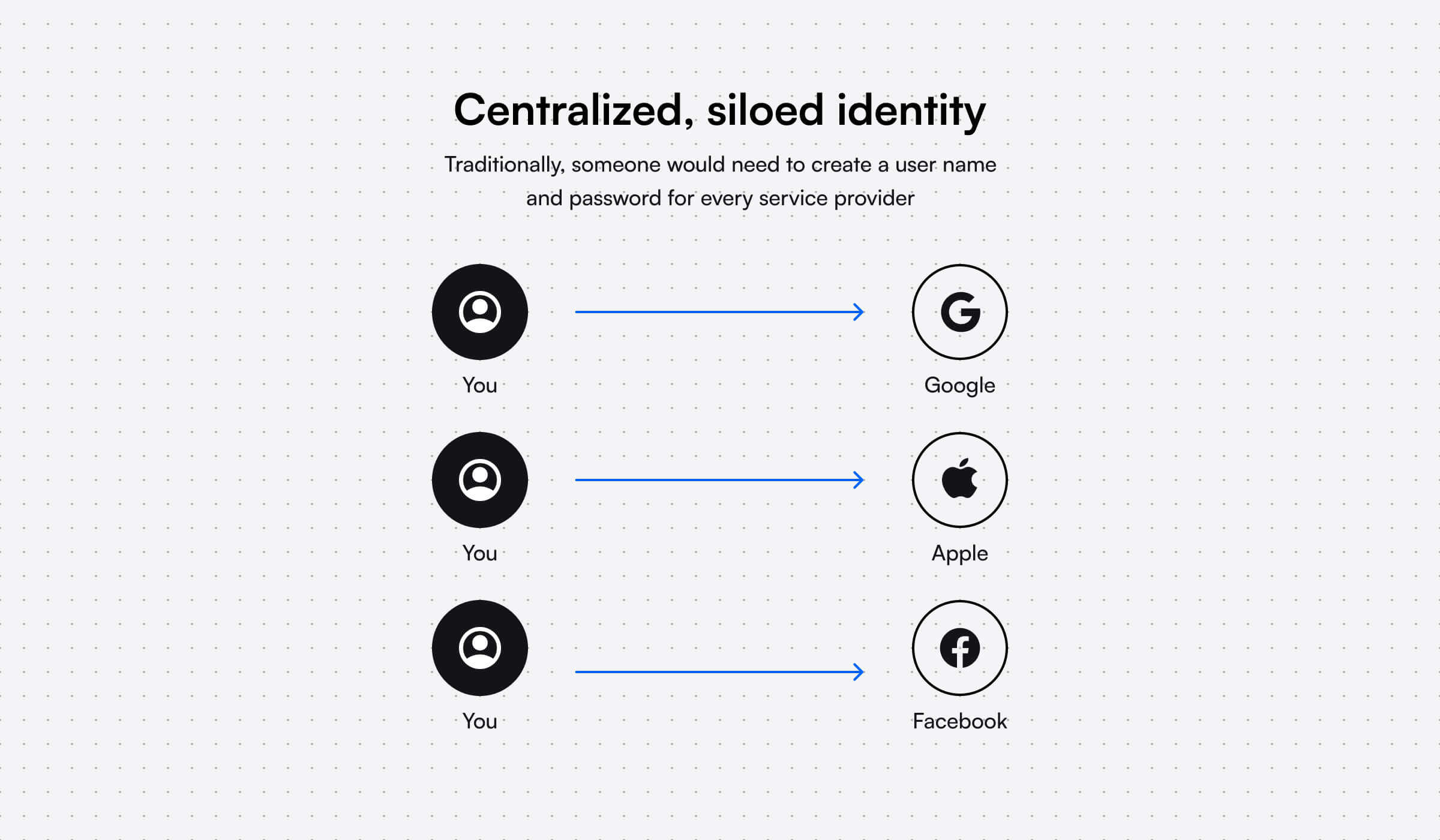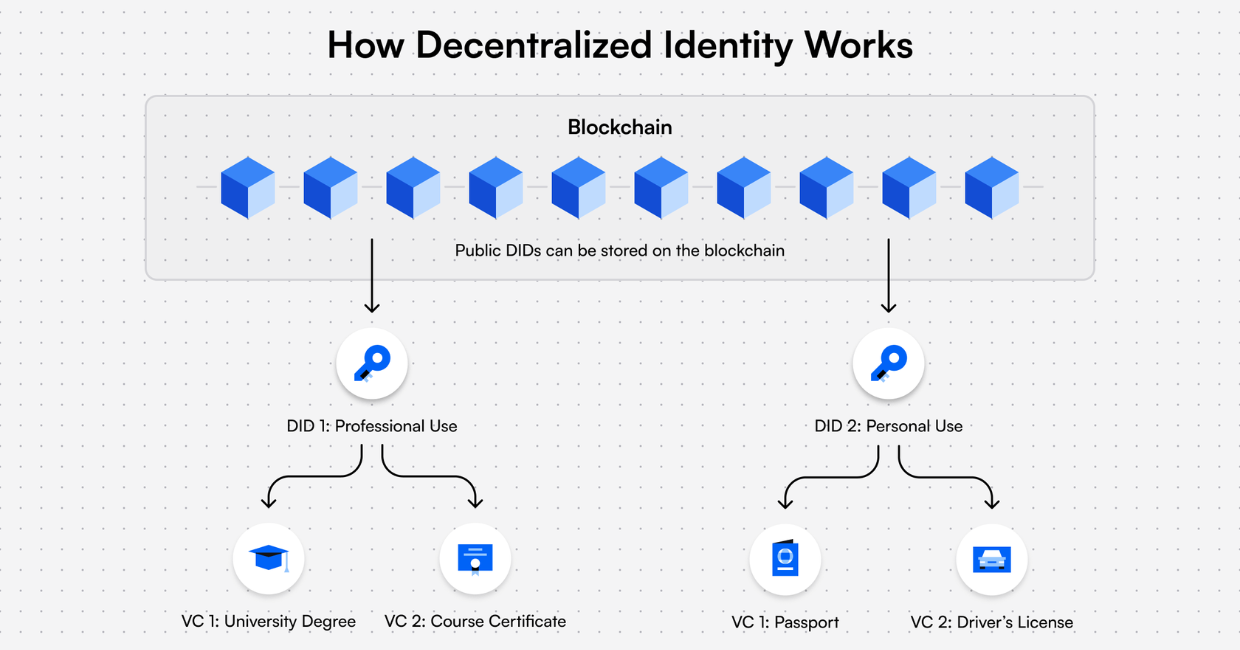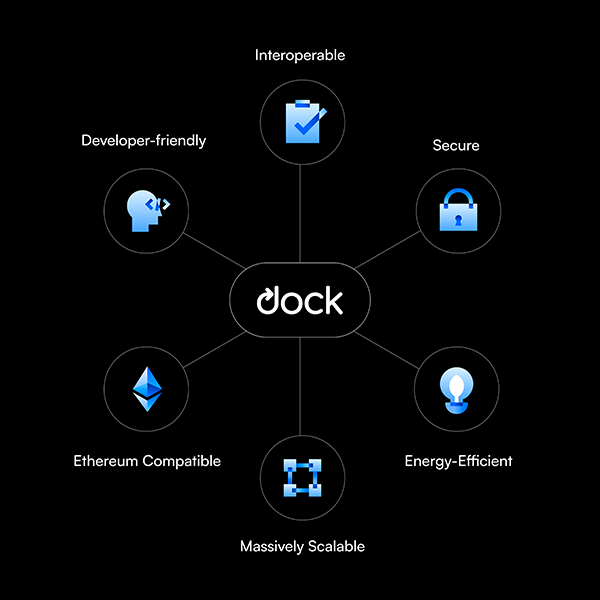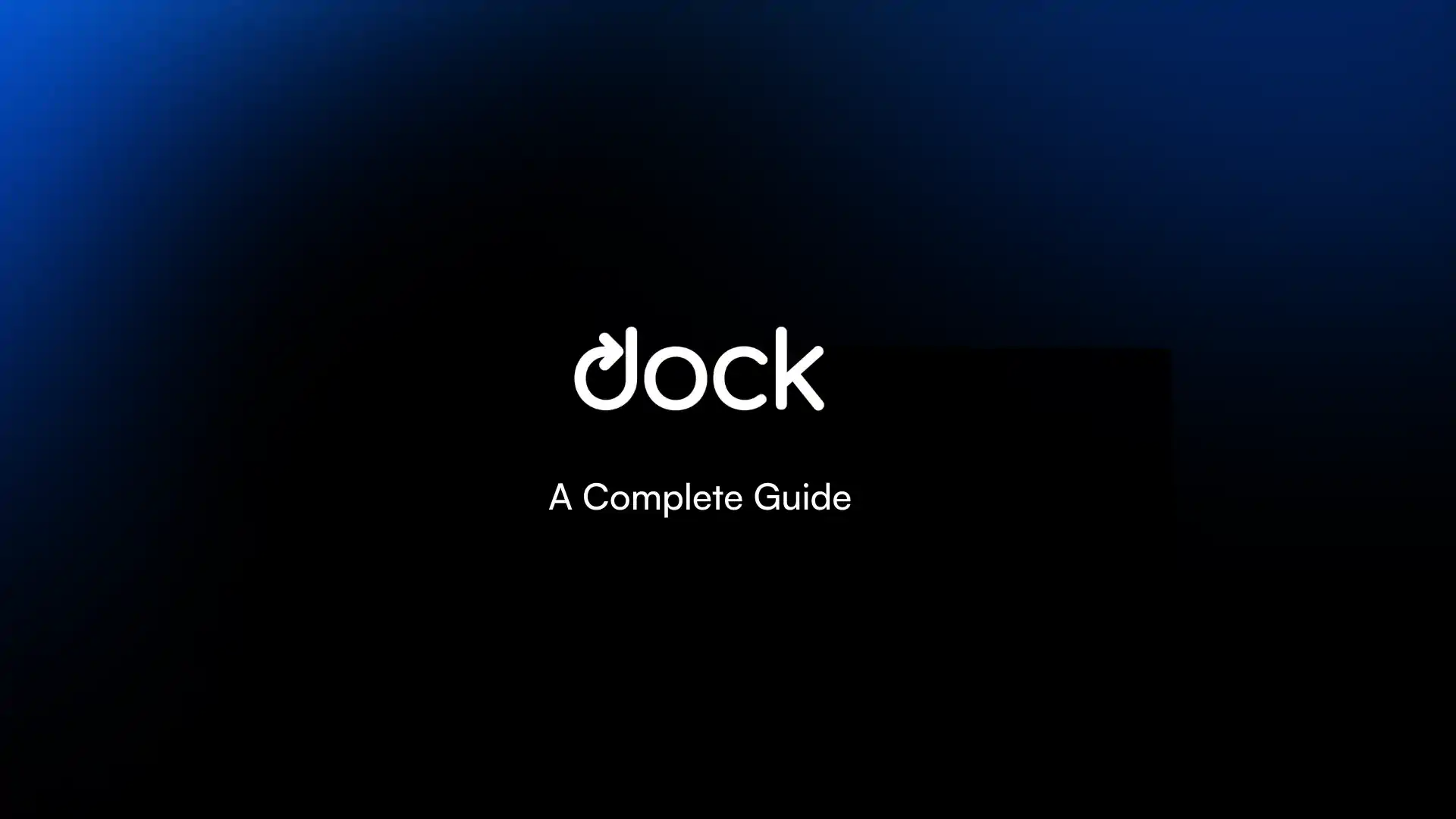Translations: Turkish | Russian | Mandarin (Chinese) | Ukrainian | Spanish | Polish
Table of Contents
Dock is building a gateway to Web3 by providing simple solutions for businesses and developers to build, manage and present digital Verifiable Credentials and decentralized identities using blockchain.
Dock provides credentialing technology that can be used to create cryptographically secure and instantly verifiable digital credentials, including workforce certificates, academic achievements, identity documents, and KYC checks.
Problems With Existing Centralized Credential Systems
Identity management has been a major concern since the internet was invented. Centralized identity management has always been vulnerable to threats, cyberattacks, and privacy breaches with a single point of failure. Billions of dollars have been spent providing a private and secure space for digital transactions.
We also know that large companies and governments control this information on our behalf. This whole control of large organizations sparked the entire movement of decentralization that propelled the applications of decentralized technologies like blockchain. The movement started with financial data and gave its origin to Bitcoin. Now this whole movement is addressing the necessity of decentralizing ownership of every data and we are calling it Web3.
Web3 is an umbrella term for the next iteration of the internet that is blockchain-based, decentralized, transparent, secure, and provides true ownership of data to its users. This will also enhance the portability and security of our identity documents such as passports, educational certificates, driving licenses, social media resumes, and more.
This is one side of the problem. There is another side where the data is having no protection from getting forged and the documents produced in various industries are getting forged. Verifying a paper-based or pdf-based certificate/credential in a fast-paced environment like today is often time-consuming and prone to errors. Hence, you can see an interconnected web of problems where the centralized database of these documents is a goldmine for hackers, the documents can be easily forged and pirated for malicious purposes, and adding to this, there is no instant verification infrastructure available.
Right from our birth, we receive numerous certificates and credentials like birth certificates, driving license, national and taxation IDs, education degrees and transcripts, and medical certificates, to name a few. From an individual to an organization, the potential documents that need to be protected, kept private, and might need authentication verification are uncountable. This is where we need a blockchain-based cryptography-enabled solution that can make any document tamper-proof with instant verification, Verifiable Credentials (VC).
Introduction to Web3 and Decentralized Identity
The Web3 movement is not only limited to ownership, it is also about how we establish trust. This vast amount of data and information individuals and organizations are generating at a massive scale remains unverified and unauthenticated. Billions of dollars have been spent only to establish 2 fundamental necessities in the ecosystem - Security and Trust.
Web3 is the next evolution of the World Wide Web that incorporates decentralization, blockchain technologies, and token-based economics.
Decentralized identity is a type of identity management that allows people to generate and control their own digitial identity without depending on a specific service provider. Web3 is about ownership and by using Dock’s technology, individuals can now truly own their most important documents and IDs and regain control over their data.

A major component of Web3 is blockchain technology. In fact, blockchain technology is the foundation on which Web3 is built since it revolves around decentralization. By building on a blockchain network, transactions are open, decentralized, and secure. Dock’s proof of stake blockchain is built for Web3.
Web3 is a newly popular term, but we have been working in this space since 2017. The Web3 Foundation recognized our efforts in the space and provided Dock with a grant to help organizations adapt and innovate in the Web3 ecosystem by helping them understand the true ownership of their data and making their documents, certificates, and credentials become digital, tamper-proof, and instantly verifiable.
What is Dock?
Dock is a pioneer in the revolutionary Web3 space. Since 2017, we have been building cutting-edge Decentralized Identity and Verifiable Credentials (VC) technology, which will act as a gateway to Web3 in the future. We have been helping organizations to adapt and innovate in the Web3 ecosystem by helping them understand the true ownership of their data and making their documents, certificates, and credentials become digital, tamper-proof, and instantly verifiable. Web3 is about ownership and by using Dock’s technology, individuals can now truly own their most important documents and regain control over their data.
Dock has built a decentralized network for issuing credentials and decentralized identifiers. But what does that mean for someone like you and me? Well, in our daily lives we come across questions like these situations:
- Is the doctor who will treat me at this hospital board certified?
- Is there an easier way to provide your necessary personal information for KYC for a bank or financial app?
Verifiable Credentials and Decentralized Identifiers Explained
A digital identity is the body of information about an individual, organization, or electronic device that exists online. Data that form a digital identity includes a user name, password, and online searches. Almost all of our digital identities are connected through devices, apps, and services.

Up till now, we have only interacted with centralized identity systems and IDs where you create an account to access a service and enter personal information. Then, you either wait to manually authenticate this information or wait for automatic processes that only create your identity but not reliably authenticate it. This may be your educational certificates, customer IDs, employee IDs, business operation credentials, passports, or driving licenses, and the list is endless. Even your email and social media accounts are also a form of digital ID that you create yourself automatically just by agreeing to the terms and conditions of the platform. However, all the data produced by you using these central identifiers are not completely owned by you and the authentication processes are taxing.
Decentralized identity systems allow users to gain control, store, and manage their own identities and data. Users decide how and when they share their data and with whom. Instead of being siloed in one place, data is decentralized to each user.

Read our complete guide on Decentralized Identity here.
Users have a digital identity wallet that stores their credentials and documents as Verifiable Credentials (VCs). Verifiable Credentials are cryptographically signed digital documents that can be instantly verified and authenticated based on the identity and trustworthiness of the issuer. Using VCs, you can prove your identity, skills and achievements, and a verifier will always know that the file was not modified or faked.

This identity wallet can hold verified user identity details such as their name, age, address, education, employment details, and financial information. The possibility to share verified information unlocks new opportunities with financial, employer, legal, and compliance-related use cases.

Learn more about Verifiable Credentials here.
Each issuer and user has a DID, a Decentralized Identifier. A DID is an identifier that belongs to you. It's like an ID, similar to your employer or student ID, and you can have more than one. The big difference is this:oday the university gives you your Student ID. But with the Web3 enabled by Dock you:
- Generate the DID for yourself
- Fully own and control your DIDsit
- Can even create a different DID for every online interaction

The DID is written on the Dock blockchain when you create your DID. For example you can have multiple DIDs for:
- Your personal interests like signing in with one DID to play on different gaming websites
- Professional purposes where you can use another DID to show educational credentials to employers when applying for a job
- Financial reasons where you create a DID to access and use financial services

Learn more about Decentralized Identifiers here.
The Dock Solution
We say Web3 will solve the problems related to data ownership, management, and security but nobody is demonstrating how. Web3, the decentralized internet built on the foundation of blockchain and cryptography has the potential to make this data secure, self-owned, and trustworthy.
This is where Dock is needed and we have built a technology that demonstrates how. We saw this problem and started to address this problem by building cutting-edge technology to ensure the data source can be known using decentralized identifiers and guaranteed (verified) using Verifiable Credentials. We have built a decentralized network for creating, issuing, and managing both Verifiable Credentials and decentralized identifiers on the Dock blockchain.
Dock’s Verifiable Credential ecosystem has the following 4 participants:

As the name suggests, the issuer is an entity that has the authority to issue Verifiable Credentials. This could be your college university issuing you a diploma after you finish the course, governmental organizations issuing you a national ID, etc.
The holder is someone who owns the credential. They store and share the Verifiable Credential from their digital wallet, in our case the Dock Wallet.
Lastly, the verifier is the one who validates or authenticates the credential. This could be a hiring company you’ve shared your diploma with.
Watch the video below to hear directly from our CEO, Nick Lambert to learn about the 4 actors of the Dock’s Verifiable Credential ecosystem.
But how is the identity verified?
The issuer issues the Verifiable Credential and digitally signs it with a cryptographic key (private key) that only the issuer can use.

When the verifier receives a credential, they will verify its authenticity through the Dock blockchain, an immutable and decentralized database.
The Dock Blockchain - Built for Web3
Dock’s Substrate-based blockchain provides an open-source, decentralized, and low-cost platform for organizations and developers to build Decentralized Identity and data applications for the Web3. Substrate is the primary blockchain SDK used by developers to create the parachains that make up the Polkadot network.
It is fast, interoperable, secure, scalable, and cost-efficient. It forms the basis of trust by maintaining a verifiable registry of all Dock-issued DIDs as well as additional functionality supporting Verifiable Credentials. Its architecture prevents the unauthorized modification of any data that is associated with a DID and the use of cryptography ensures that Verifiable Credentials are not tampered or forged.
Everyone using Web3 will need their own Decentralized Identifiers (DIDs). The Dock blockchain serves as the entry point with a protocol layer for all things Web3. Our blockchain-based credentialing system adheres to W3C standards. W3C is an international community where member organizations, full-time staff, and the public work to set international standards for the World Wide Web. They created standards for URL, decentralized identifiers, and others.

The Nominated Proof of Stake Consensus
Dock runs its own validator network and our blockchain is built on Substrate (which is the same framework used throughout the Polkadot ecosystem). It uses the consensus mechanism offered by Substrate, which is a hybrid as it separates block production and finality and achieves them through different methods. The blockchain has the same consensus and governance mechanism as Polkadot.
In simple terms, nominated Proof of Stake (NPoS) is the process of selecting validators to be allowed to participate in the consensus protocol. NPoS is a Proof-of-Stake variant that is used in Substrate-based Blockchains like Dock, Kusama, Edgeware, and Polkadot.
Nominated Proof of Stake has two entities in its space, the Nominators and the Validators. Nominators select validators they would like to process transactions, produce blocks, and validate transactions. They do so by staking Dock tokens. Validators process transactions, produce blocks (by putting transactions in blocks) and finalize them. They also validate blocks produced by other validators.
Learn more about governance on the Dock blockchain here.
Consensus and Framework
Dock uses the consensus mechanism offered by Substrate. The finality is achieved through a finality gadget called GRANDPA (GHOST-based Recursive Ancestor Deriving Prefix Agreement). It finalizes chains rather than individual blocks and offers provable finality.
When Dock transitioned into utilizing PoS, the block production algorithm changed from Aura to BABE (Blind Assignment for Blockchain Extension protocol) which selects a validator for each slot (interval of time) randomly using a VRF (Verifiable Random Function).
Dock Staking
There are 50 validators running the Dock blockchain at any given time. We are glad that Binance joined this group back in January 2022, which also includes highly regarded staking companies like Everstake, Stakin, Ryabina, My Container and others. All Dock token holders can participate in staking to earn rewards in the form of Dock tokens.
Dock Product Suite
Dock’s products are already capable of serving the largest organizations to instantly issue Verifiable Credentials and create decentralized identifiers on their own blockchain. We provide all of the necessary products for individuals and organizations to hold and manage these DIDs and Verifiable Credentials on a secure wallet app and verify these credentials.
Certs
We provide both ready-made and customizable VC and DID opportunities for companies and developers. Users can opt for whichever seems most convenient. Organizations that want to issue Verifiable Credentials without writing a line of code can simply use Dock Certs.

Users can sign up for Dock Certs in a few clicks and start creating their Decentralized Identifiers (DIDs) and Verifiable Credentials. After the creation of the credential, organizations can send it to the user as a link in an email, a PDF or a JSON file. The JSON file can be saved in the user's digital identity wallet. Cryptography is used to ensure that the credentials were not modified since they were issued.
Certs API
Certs is available in both no-code and API versions. Dock offers developer-friendly APIs to easily and instantly issue, verify, manage, and revoke Verifiable Credentials and Decentralized Identifiers on the Dock blockchain.
Wallet SDK
Using Dock Wallet SDK, developers can build a Verifiable Credentials wallet inside their own app and allow their users to store, receive, and manage their credentials as well as DOCK tokens.
Web3 ID
Web3 ID is a blockchain-based authentication and authorization system that puts user privacy first. It allows organizations to securely request private user data and the user has the option to give permission to reveal the information or confirm it without revealing the data at all. Web3 ID enables people to fully own and control their digital identity.
Dock Wallet App
Individuals can store and manage these DIDs and Verifiable Credentials in a secure Dock wallet app. With the Dock Wallet, you can now store your digital Verifiable Credentials and truly own your professional and educational achievements.
All your data will not be stored on the Dock Blockchain. You will have complete control on your credentials via your personal app.
This wallet can also be used to store, send, receive, and buy DOCK tokens.
Dock Partners and Clients
Dock has partnered with Auth0, one of the world's leading identity management company in 2022. This collaboration made Dock's Web3 ID available in Auth0's marketplace for all their clients and customers. We are also working with SEVENmile, an Australian-based organization that is using Dock Certs to issue educational qualification certificates to the students who are completing courses with their platform. BurstIQ, one of the leading Healthcare and Life Sciences data solutions providers has implemented Dock's technology to make healthcare data verifiable, portable, and secure.
Winners of the prestigious Odyssey Momentum Hackathon, overhd has utilised our open-source software to implement and host a permissioned blockchain as well as leveraged Dock’s features of creating VCs and DIDs.
Dock has also advised Deutsche Gesellschaft für Internationale Zusammenarbeit (GIZ) GmbH, a German development agency commissioned by German Federal Ministry for Economic Cooperation and Development (BMZ). Dock assisted them with the technical architecture and features for a professional profile data wallet linked to atingi, a digital learning platform built by GIZ.
We have also announced several partnerships including Credenxia, an Australian workforce training company, and Xertify who is working on several pilots for COVID vaccine credentials in Mexico and Columbia. We are working with additional partners that will be announced later.
Dock Use Cases
Use cases for adopting Dock’s technology include healthcare, education, supply chain, finance, compliance, NFTs, DeFi, and many more sectors that rely heavily on credential data.
Let’s take the example of NFT marketplaces. Fraud is rampant both within and outside of the blockchain space, and NFTs are no exception with scammers setting up fake accounts and selling fake NFTs. A Verifiable Credential can be used to verify the identity of all parties involved in creating, buying, and selling NFTs, to ensure the reputation and authenticity of everyone involved without divulging private information. For example, an NFT creator could share a verifiable Credential that demonstrates a history of creating legitimate NFTs, or a seller can have a Verifiable Credential that shows a reputation score based on their previous NFT sales. And they can do this while remaining anonymous!
Here are some other examples of our use cases:
- Healthcare: Dock is working with a healthcare technology company that has created an ecosystem of credential issuers, employers, and individuals. We provide a platform to streamline credential issuing, verification and monitoring. With the use of Verifiable Credentials and blockchain, their product enables issuers to create digital Verifiable Credentials and a mobile app for individuals to store, share, and instantly verify in real-time. Learn more here.
- Supply chain: Dock’s core technology can help businesses and government authorities ensure a legal and compliant supply chain with genuine goods and materials in addition to timely, reliable deliveries. The end results are significant savings in administrative expenses and increased profitability. Learn more here.
- E-learning / Education: The PDF certificate issued by e-learning platforms can easily be copied and imitators can fake their accomplishments. Adding a cryptographic signature by the issuer (the institute) using Certs or Certs API will make this certificate tamper-proof, instantly verifiable, and unique. Dock’s VC and VP can also help prevent cheating in academic and professional exams by confirming test taker’s identity. Learn more here.
- Employment: Dock Network streamlines the hiring process by providing credentials that are cryptographically verifiable. This can simplify and speed up the hiring process for both job seekers and employers by enabling instant and reliable verification of candidates’ skills and experiences. The end results are huge savings in administrative costs and increased trust in the talent pool.
- Financial Services: Identification and compliance practices are extremely important in providing financial services. Dock provides the technology to solve these verification challenges in the financial industry. Using Certs, Verifiable Credentials can be issued to provide a spectrum of financial and identity information that individuals and companies can present in order to unlock access to services. Learn more here.
DOCK token
All transactions to the Dock Blockchain, like creating DIDs, updating Revocation Registries, and creating Schemas amongst others, require DOCK tokens. The use of DOCK extends further to other initiatives that include governance and staking.
The utilities of DOCK can be divided into 3 main categories:
- Governance: Token holders can actively participate in submitting proposals, voting, and electing council members
- Network operations: Dock tokens are used to pay for transactions in the network such as creating DIDs, anchoring and revoking credentials, and sending payments
- Staking and validating: Validators are paid emission rewards for validating and those rewards are shared with nominators who support them
The total supply of DOCK tokens is fixed at 1 billion. Out of which 70% is with holders, 15% is with the Treasury and Dock Association, and 15% is for emission rewards.
According to the team, the circulating supply is 770 million and the emission of the remaining DOCK will happen over 25 years distributing 25-30% per year. DOCK’s token emission schedule can be found here.
The Dock Team
The Dock Network is supported by two entities:
- Dock Association: A Swiss non-profit Association dedicated to overseeing the network’s roadmap, establishing and providing ongoing governance, overseeing the promotion of the network and also driving its adoption.
- Dock Labs: The team behind Dock working on developing the technology and driving marketing, business development, and operations to fulfill Dock’s vision.
The team is led by Nick Lambert and Elina Cadouri who come with a wealth of experience in the blockchain and data tech industry. Nick, CEO at Dock, has been working in the blockchain industry since 2011 and was the COO of one of the earliest companies working in the Blockchain space, MaidSafe. Elina, COO of Dock, has remarkable experience in the data network industry. Lead Developer Lovesh Harchandani is an expert in the Verifiable Credentials and Decentralized Identity industry creating one of the most innovative solutions at Dock, and previously at Evernym. You can read more about our team and our entities here.
Final Conclusions
Web3 is not only about the Metaverse and NFTs. It is also going to be largely about data ownership. Web2 uses centralized identifiers like social media accounts and email addresses to access websites and apps while a Web3 ID will enable you to surf, transact, or share your data securely on a decentralized internet while fully owning and controlling your digital identity.
This Web3 ID:
- Will carry your credentials, IDs, your reputation, and the linked data in a decentralized digital wallet
- Opens multiple use cases in DeFi and NFT marketplacesEnables the ability to prove/verify transactions and ownership of assets without revealing wallet address or the entire history of transactions
Dock already has all of the technology and tools to support functionality for decentralized identities. Adding the support of Verifiable Credentials is a powerful and secure way to add trust and authenticity to every credential, document, or certificate used in Web3 while ensuring the privacy of everyone participating.

